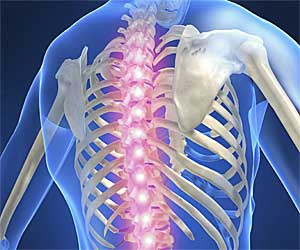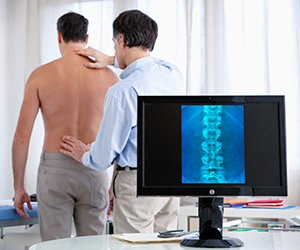
Epidural Steroid Injections (ESI)
In an Epidural Steroid Injection, a local anesthetic and steroid is injected into the epidural space. This is the area that surrounds the spinal cord and the spinal nerves. The purpose of the injection is to reduce pain by reducing any inflammation of the nerves in the area of the injection site. The injection only takes a few minutes and is usually performed in the office under conscious sedation.
Facet and Medial Branch Block Injections
Facet joints help support weight and control movement between each vertebrae. Facet joints are innervated with nerves called medial branches. These are the nerves that conduct pain to the spinal cord. If the nerves are blocked using a numbing medication, they will not be able to conduct pain signals to the spinal cord. If your pain is being caused by the facet joint, this procedure should help. The numbing medication will typically last no longer than 24-48 hours. This procedure is done in the office.
Radiofrequency Lesioning (RFL)
Radiofrequency Lesioning (RFL) is the procedure that takes place after a patient has undergone at least 2 successful Medial Branch Blocks (MBB). This procedure typically lasts 6-9 months, but can last as few as 3 months and as many as 18 months. The procedure is used to interrupt nerve conduction in order to decrease pain symptoms. This procedure is typically done in the office under conscious sedation.
Discography
Discograms are done as a diagnostic procedure to determine if your pain is caused by disc degeneration. The procedure is done by a physician in two steps. Step one, the physician will inject x-ray dye into the discs of the spine. Once the dye is injected, the patient will proceed to step two, an x-ray or CT scan of the discs. The physician will then be able to determine if there are any tears or fissures in the discs. Step one is typically done in the office under conscious sedation. The patient will then be taken to radiology in the hospital for step two.

SI Joint Injections
Sacro-Iliac (SI) Joint Injections are performed to decrease inflammation and swelling of the tissue in the specific joint space. The is done by injecting Cortisone, a steroid, into the SI joint, which is located in the low back. This procedure is usually done in the office.
Trigger Point Injections
Sometimes pain is caused by muscle spasms caused by one or more trigger points. Trigger points are painful "knots" of muscle fiber that form where a muscle is strained or injured. Once the trigger points are located, they will be injected with a local anesthetic to numb the area and thus relieve your pain.
Vertebroplasty
Vertebroplasty is a procedure that is done to decrease pain caused by compression fractures. The procedure is done in the office under conscious sedation. The physician will inject a bone cement into the vertebrae to help stabilize fractures and decrease pain.
Spinal Cord Stimulator Trial and Implantation
There are many types of treatment for pain depending on its type and severity. To reduce this pain, your doctor may suggest physical therapy, medications or surgery. When these methods of treatment fail, your doctor may suggest the use of a spinal cord stimulator. Spinal Cord Stimulators (SCS) have been used for over 30 years with patients who experience pain that is chronic and does not respond to other types of treatment.
The SCS works by implanting a medical device that produces a tingling sensation that alters the perception of pain. The electrodes are placed in the epidural space and the battery is placed in the hip, abdomen or buttocks.
The SCS implantation is done in two phases.
Phase I is the Trial Phase. This phase allows the patient to experience the actual benefits of the SCS without having the system implanted on a permanent basis. This external version of the SCS will be tried by the patient for about a week. After the trial period, you and your doctor will decide if the SCS is right for you. If you both decide the SCS fits your lifestyle and helps with your pain, you will begin Phase II of the process.
Phase II is the Implant Phase. You will undergo a minor procedure to internally implant the SCS system. It will be very similar to the Trial Phase, except the battery or generator will be implanted into your hip, abdomen or buttocks. You will be asked to come into the office for further programming and fine tuning to ensure that you are getting the most precise coverage with the system as possible.
For more information about the use of an SCS, please ask your doctor if it is appropriate for the treatment of your pain.

Intrathecal Pain and Baclofen Pump Trial and Implantation
Intrathecal pumps are implanted when all other conservative treatments fail. This procedure is done in two phases, and different medications can be used. Different pain medications can be used to reduce pain, including morphine, dilaudid, fentanyl and others. Baclofen is a medication used to reduce spasticity related to spinal cord injuries, MS and other neurological diseases.
Phase I is the Trial Phase. The patient will be admitted to the hospital for approximately 3 days. A catheter will be placed in the epidural space and drugs will be delivered directly to the spinal cord. This phase is used to determine if the system will help decrease your pain or spasticity. During your stay at the hospital, your physician will determine the best dosage of medication to reduce your pain and you will decide together if the system is best for your lifestyle. If it is determined that the system is beneficial, you will continue on to Phase II.
Phase II is the Implant Phase. The catheter will be placed into the epidural space and the pump that controls how much medication is released will be implanted into the hip, buttocks or abdomen. The size of your pump and the amount of medication that is administered each day will depend on how often you have to have your pump refilled. When the time comes for your pump to be refilled, you will come to the office for your refill.
Regenerative Therapy
Scientists and doctors have made tremendous advances to make tissue regeneration a reality in treating many diseases. Through regenerative medicine, a person can take advantage of their body’s ability to heal itself by using the healthy adult stem cells that can be found throughout the body. Laboratory and clinical research has shown that it is possible to use adult stem cells to restore lost, damaged or aging cells and effectively regenerate tissue in the body. Regenerative therapies are showing promise in the treatment of orthopedic pain. In adults, stem cells are present within a variety of tissues and organs. The most common and richest source comes from your bone marrow. During your stem cell therapy procedure, the doctor will use a needle to withdraw bone marrow from your posterior Iliac crest (lower back area). A trained technician then uses specifically designed equipment to concentrate the adult stem cells and growth factors present in the bone marrow and provides the cells back to the physician for implantation into the targeted area(s).
M.I.L.D (Minimally Invasive Lumbar Decompression)
The mild® Procedure provides increased mobility and relieves pain in the lower back, legs and buttocks for patients with lumbar spinal stenosis. Through an incision the size of a baby aspirin (5.1mm), a trained mild® physician removes small pieces of bone and thickened ligament. This restores space in the spinal canal, which reduces the compression of the nerves. This short, outpatient procedure is FDA-cleared and takes less than an hour to complete. Most patients are generally able to return home a couple hours after the procedure and resume light activities within just a few days. mild® is a safe, outpatient procedure that relieves pressure in your spinal canal by removing excess ligament tissue.
• No implants
• No general anesthesia
• No stitches
• Resume light activities within a few days
• Covered by Medicare nationwide
